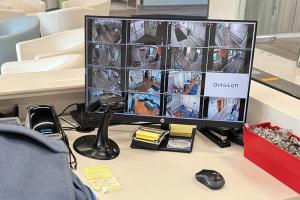You can’t innovate if you don’t communicate

Image from Getty Images
Our story begins in Bern, Switzerland, at the turn of the 20th century. We follow a young man from Germany walking into the Swiss Federal Intellectual Property Agency on the way to his job as a Class 3 technical expert in the agency’s patent office. As he walks up the stairs, people pass him with a “Salü, Albert,” which is Swiss German for “hello.” Sometimes he acknowledges them, but other times he does not respond, aloof and lost in thought. He is toying with the immutable laws of physics in his head, laws established three or four centuries prior.
Then one day, after 10 years of thought, it finally occurs to him: What if light, instead of time and distance, is the constant? From there a simple equation, E = MC2, is born. Satisfied with his innovation, Albert doesn't tell anyone, doesn't write the paper "Does The Inertia of a Body Depend on its Energy Content?," doesn’t change the course of history and doesn’t provide Walter Matthau the opportunity to play the irascible physicist helping Tim Robbins and Meg Ryan find love in 1994’s “I.Q.”
But we all know that isn’t the way the story goes. He did write that paper, which shook the foundations of so many physicists around the world. He did speak about his discovery, gaining converts to his beliefs. His beliefs were put into action by others who encountered this revolutionary perspective in conversation or through the written word. Albert Einstein’s innovation was the first step. Communicating that innovation was the next step and the one after that, which ultimately changed the world.
Effective communication is key to impactful innovation
No matter what type of innovation you’ve enabled, the use of power skills in order to ensure the impact of that innovation is paramount to its success. Communication is a power skill that has lots of direct impact on the salability and scalability of your innovation.
In his January 2022 Forbes article, “When Communication Is At Its Best, So Is Innovation,” Alex Goryachev, former general manager of the global innovations center at software and hardware development company Cisco, writes, “Working in solitude may lead to invention, but not innovation, because [innovation] requires communication with others. To bring change, you must communicate effectively with multiple audiences, understanding what they care about and how best to connect with them. Internally, the focus is not just on your employees, but also on your fellow leaders, managers, executives and stakeholders. Externally, you’re speaking to your customers and partners of course, but you also want to make your voice heard by the rest of your industry, competitors, collaborators and the public, as many of them are potential consumers or employees."
In Goryachev’s February 2018 article, “Three Reasons Why Innovation Is All About Communication,” he quotes Chris Anderson, magazine magnate and chief curator of TED Talks, talking about the power of communication to support innovation. Anderson states, “Every meaningful element of human progress has happened only because humans have shared ideas with each other and then collaborated to turn those ideas into reality. From the first time our ancestors teamed up to take down a mammoth to Neil Armstrong’s first step onto the moon, people have turned spoken words into astonishing shared achievements.”
The innovation adoption continuum
Whether you’ve discovered a new formula to index your facility’s condition, an improved approach to designing a behavioral health ward within an existing building or a brand-new schematic for a chiller that provides the same level of performance and uses half the amount of energy to do so, gaining buy-in for your innovation depends on understanding what and how to communicate about your innovation.
No one understands the mechanics of communicating innovation better than the late Everett Rogers, a sociologist who introduced the term “early adopter” into our lexicon. Rogers developed what he called the “Diffusion of Innovation Theory,” which posited that in order for an individual to want to adopt an innovation, that person would need to overcome their uncertainty about that innovative product or process. Rogers outlined five characteristics of innovation and their impact on a person’s adoption of that innovation:
- Relative advantage. The ability to observe, on its face, the relative strengths of adopting a specific innovation.
- Compatibility. The ease with which an innovation fits into a person’s needs, usage patterns and/or current value system.
- Complexity. The level of difficulty that the potential adopters encounter with the innovation.
- Trialability. The ability to test an innovation or try it out.
- Observability. The ease by which the benefits of an innovation are visible to the target population.
To use a real-world example illustrating Rogers’ theory, consider the iPhone. When the iPhone was launched in 2007, there was already a booming market in mobile phones. Compatibility with mobile phone usage patterns was already established by other companies.
Apple itself had established usage patterns related to mobile music players with its iPod product. Internet browsers existed for almost a decade by the time iPhone launched. So when Steve Jobs first announced the iPhone as “an iPod, a phone and an internet browser” all in one, he illustrated the observability and relative advantage of Apple’s new product very successfully.
Apple Stores, launched in 2001, gave potential customers the opportunity to explore the trialability of the innovative new product in person. Seventeen years later, Apple has sold 2.3 billion iPhones. So, when you are working on the communication of your innovation to internal and external audiences, contrast your communications plan with that of the iPhone. Is it as well designed in covering all the bases of Rogers’ Diffusion of Innovation Theory?
The five stages of innovation adoption decisions
In addition to outlining the five characteristics of successful innovation adoption, Rogers also educated the world on the five stages of innovation adoption, which provide an important lens when considering what you are communicating to a particular audience given their current stage in the adoption cycle.
- Awareness. A passive stage where an individual is aware that an innovation exists but whose details have not yet been communicated.
- Attitude. An individual seeks more information about an innovation to determine if that innovation will help them.
- Adoption. An individual has decided to adopt an innovation and examines it to determine whether it will make their lives easier or better. This stage is highly influenced by friends and neighbors close to them.
- Implementation. An individual tests the innovation to see if reality matches expectations, usually through small-scale, experimental efforts. This stage is influenced by any source of information that is determined to be helpful to effective implementation.
- Confirmation. An individual likes the innovation, adopts it into all applicable uses and becomes a strong advocate for the innovation in their community.
Lessons from other industries
Let’s again use the iPhone as a real-world example through the lens of a 5-foot, Jewish, baby boomer woman from Chicago. We can see how this individual, let's call her “Mom,” went through all the stages of innovation adoption Rogers lays out. Let’s put together a composite of many different conversations (oh, so many conversations) to illustrate the theory.
While I work through the horrible memories this little scenario has resurfaced, think through examples in your own life of how you became aware of, learned about, adopted and advocated for product or process innovations. How are you leveraging those experiences when planning communications around your own innovations?
The tongue is more powerful than the tool
The history of the world is made up of thousands of examples of successful innovations that were adopted and improved the lives of countless individuals. You know what the history of the world is not made up of? The thousands of examples of successful innovations whose inventors did a lousy job of communicating about them to prospective audiences.
Technical knowledge is so important in the invention of a new tool, one that will help to make your job easier and more efficient, making you and others like you more effective in the outcomes that are delivered. But that tool and the technical knowledge behind it, without the power skill of communication to help advocate for why that tool is better than the one currently in use, will lead to low adoption rates and dashed hopes. Work hard to have those eureka moments. Then work harder to tell everyone about them.
Adam Bazer, MPD, is senior director of knowledge product development at the American Society for Health Care Engineering.





